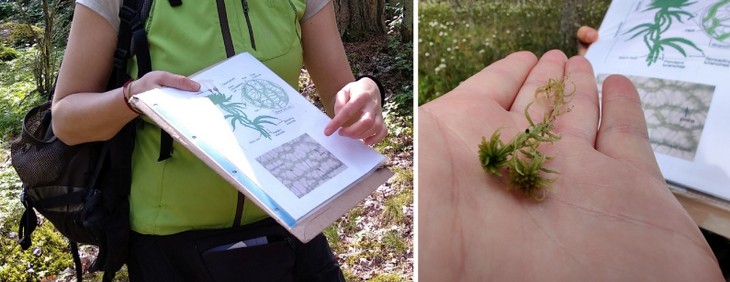Sphagnum - more than just a tiny moss
Peat mosses (Sphagnum spec.) are of high importance both ecologically and economically. Worldwide there exist about 380 Sphagnum species (Sphagnaceae), which can only be distinguished by specialists. Oftentimes, even a microscope is necessary to identify the differences between some species.

Fig.1: Variety of peat mosses (Sphagnum spec.) in Sörmland (2020-2021).
All Sphagnum mosses consist of a central stem with side branches and small leaves. As under the taxonomic division Bryophyta, peat moss, like all other mosses is a non-vascular plant. It therefore doesn’t have any vascular system for the inner transport of water and nutrients. Its cells are simply so thin that water can move in an out by diffusion. As a result of this, mosses can be dehydrated easily. Sphagnum species are made up of only two types of cells! One type contains chlorophyll and is responsible for photosynthesis. The other cells, so-called hyaline cells, are barrel shaped and serve as water reservoir. Through pores they can soak up water like a sponge. Sphagnum mosses can store about 25 times as much water as their dry weight. Moreso, they can release the stored water through the pores in order to keep the environment boggy.

Fig.2: Chlorophyll cells (green) and hyaline cells (white) of a Sphagnum species under the microscope.
Since it only consists of a stem and leaves, Sphagnum doesn’t have any roots or rootlike system. It keeps on growing from the top, while its lower parts start decomposing because of lack of oxygen. Thus, peat mosses, as the name suggests, contribute significantly to the buildup of peat. The following picture shows a bunch of peat moss with long stems that turned yellow/white while dying off.

Fig.3: Bunch of Sphagnum moss in Sörmland (2021).
Peat mosses grow best in wetlands with an acidic soil chemistry. They are the main species making up bog ecosystems and since dead plant material doesn’t decompose fully under these conditions, peat is formed over long periods of time. While many other plants cannot survive in those extreme environments, peat moss itself is perfectly adapted to the acidic conditions and even enhances them by excreting acidic components into its surroundings. Therefore and because of its ability to influence the hydrology of the ecosystem, Sphagnum is called a ‘habitat manipulator. It simply adapts its surrounding to what best suits itself and some other adapted species.
Peat bogs are inhabited by extremely specialized plants and animals which often occur exclusively in those ecosystems. The cultivation of bogs in order to gain land for agricultural use and other purposes put several species under pressure, since they are adapted to these specific environments only.
Furthermore, huge amounts of carbon dioxide and methane are bound in the bogs and released through their destruction. Cultivation of peat bogs therefore also contributes to global warming in a massive and often underestimated extent, while unimpaired bogs naturally absorb carbon dioxide and keep it fixed in peat for potentially many thousands of years – if humans wouldn’t extract it again.
Odd fact: Sphagnum mosses were used during World War One as a substitute for cotton in hospitals. It not only can absorb liquids up to 25 times of its dry weight but also has antiseptic qualities, which of course were highly valued in times of war and unhygienic conditions. Peat moss had as well been used in babies’ nappies and is still a large component of many types of soil, which each of us can buy in garden centers. Unfortunately, one who might be enthusiastic about creating their own garden, unconsciously could contribute to the destruction of peat bogs.
In the forests of Sörmland, Sphagnum can be found almost everywhere! It’s by far not limited to peat bogs but often occurs in small depressions where the macro-habitat is a bit moister than in the surrounding dryer forest.
Personally, I’ve fallen in love with those mosses. Even though I cannot distinguish all species, I love to see their variety and to discover differences in shape and color. To me, Sphagnum moss is a real beauty! In all guided tours, my guests get to learn about peat mosses. They can easily be found and since they aren’t rooted to the ground, I can pick them up and put them pick without causing any harm to them.

Fig.4: Me talking about Sphagnum moss during my guided tours (left 2021, right 2020).
You can find out more about my guided hikes in Sörmland on my website Sweden Experience Tours.
Post sources:
- Oxford University: https://herbaria.plants.ox.ac.uk/bol/plants400/Profiles/ST/Sphagnum?msclkid=b7e1ad75b8ae11ec8b8904bf98c19a41
- UCMP Berkeley: https://ucmp.berkeley.edu/plants/bryophyta/sphagnointro.html?msclkid=c8d08658b8ae11eca5281c83ade81cdd
- Sphagnum Wikipedia: https://en.wikipedia.org/wiki/Sphagnum
- Moss - Wikipedia: https://en.wikipedia.org/wiki/Moss?msclkid=ebc41452b8ae11ecb2c5b933e9cd71ea
There are no reviews yet.